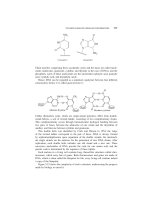Physical chemistry of solids basic principles of symmetry and stability of crystalline solids
Bạn đang xem bản rút gọn của tài liệu. Xem và tải ngay bản đầy đủ của tài liệu tại đây (13.61 MB, 297 trang )
www.pdfgrip.com
This page is intentionally left blank
www.pdfgrip.com
PHYSICAL CHEMISTRY
----OF SOLIDS ---Basic Principles of Symmetry
and Stability of Crystalline Solids
www.pdfgrip.com
This page is intentionally left blank
www.pdfgrip.com
Advanced Series in Physical Chemistry - Vol. 1
PHYSICAL CHEMISTRY
-----OF SOLIDS ----Basic Principles of Symmetry
and Stability of Crystalline Solids
H. F. Franzen
Iowa State University, USA
Editor-in-Charge
C. Y. Ng
Iowa State University, USA
b World Scientific
II
'
Singapore • New Jersey· London • Hong Kong
www.pdfgrip.com
Published by
World Scientific Publishing Co. Pte. Ltd.
P O Box 128, Fairer Road, Singapore 9128
USA office: Suite IB, 1060 Main Street, River Edge, NJ 07661
UK office: 57 Shelton Street, Covent Garden, London WC2H 9HE
Library of Congress Cataloging-in-Publication Data
Franzen, H. F. (Hugo Friedrich), 1934Physical chemistry of solids : basic principles of symmetry and
stability of crystalline solids / H. F. Franzen ; editor-in-charge,
C. Y. Ng
p. cm. ~ (Advanced series in physical chemistry ; vol. 1)
Includes bibliographical references and index.
ISBN (invalid) 9810211538. -- ISBN (invalid) 9810211546 (pbk.)
1. Solid state chemistry. I. Ng, C. Y. (Cheuk-Yiu), 1947II. Title. III. Series.
QD478.F73 1993
541'.0421-dc20
93-45345
CIP
First published 1994
First reprint 1995
Copyright © 1994 by World Scientific Publishing Co. Pte. Ltd.
All rights reserved. This book, or parts thereof, may not be reproduced in any form or by any means,
electronic or mechanical, including photocopying, recording or any information storage and retrieval
system now known or to be invented, without written permission from the Publisher.
For photocopying of material in this volume, please pay a copying fee through the Copyright
Clearance Center, Inc., 222 Rosewood Drive, Danvers, Massachusetts 01923, USA.
Printed in Singapore.
www.pdfgrip.com
INTRODUCTION
Many of us who are involved in teaching a special topic graduate course
may have experienced difficulty in finding suitable references, especially reference materials put together in a suitable text format. Presently, several
excellent book series exist and they have served the scientific community
well in reviewing new developments in physical chemistry and chemical
physics. However, these existing series publish mostly monographs consisting of review chapters of unrelated subjects. The modern development of
theoretical and experimental research has become highly specialized. Even
in a small subfield, experimental or theoretical, few reviewers are capable of
giving an in-depth review with good balance in various new developments.
A thorough and more useful review should consist of chapters written by
specialists covering all aspects of the field. This book series is established
with these needs in mind. That is, the goal of this series is to publish
selected graduate texts and stand-alone review monographs with specific
themes, focusing on modern topics and new developments in experimental
and theoretical physical chemistry. In review chapters, the authors are
encouraged to provide a section of future developments and needs. We
hope that the texts and review monographs of this series will be more
useful to new researchers about to enter the field.
Cheuk-Yiu Ng
www.pdfgrip.com
This page is intentionally left blank
www.pdfgrip.com
PREFACE
I have written this book with the intention of providing a handbook of some
of the major physical-chemical concepts important in the preparation, determination of structure, study of structure change and understanding of
elementary band structure of crystalline solids. The book is designed to
answer many of the conceptual questions that I have found to arise in my
research and that of my students and colleagues. An understanding of the
material of undergraduate Physical Chemistry is assumed, and the availability of more advanced texts in specialized areas of symmetry, thermodynamics, crystallography, quantum mechanics and band theory is taken for
granted. The book was written in the hope that it will become for many
a first source for a deeper understanding of the experiments that many
perform in probing crystal chemistry.
Some of the specific areas for which concepts significantly beyond the
treatments found in standard Physical Chemistry texts are developed in
some detail are: (1) lattices and their interrelations, (2) space group symmetry, (3) irreducible representations of space groups, (4) phase transitions,
especially second-order phase transitions, (5) group-subgroup relations, (6)
heterogeneous equilibrium and the phase rule, (7) X-ray diffraction (singlecrystal and powder), (8) structure determination, (9) order-disorder transitions, (10) incommensurate structure, (11) symmetry aspects of band
structure and (12) least squares treatment of data.
Some of the specific analytic tools that are introduced are: (1) the systematic treatment of space lattices, (2) cell reduction, (3) Seitz operators,
(4) the determination of full space-group symmetry from a set of generating elements, (5) reciprocal lattice and space, (6) loaded representations,
vii
www.pdfgrip.com
viii
Physical Chemistry of Solids
(7) Landau theory of symmetry and phase transitions, (8) independent net
reactions, (9) configurational entropy, (10) the Ewald sphere, (11) the Fresnel construction, (12) statistical analysis of diffraction, (13) Brillouin zones
and zone boundary effects (PeierPs distortion) and (14) Fourier analysis.
With such a broad range it is of course necessary that readers be referred
to more advanced texts, and reference texts, as well as a few relevant scientific articles are listed in bibliographies at the end of each chapter. Each
chapter is followed by a collection of problems for which detailed solutions
are provided in an appendix.
It is hoped that the book will find use as a desk-top ready reference to
which researchers will turn when confronted by a puzzle in the interpretation of experimental results, and that it will also stimulate further interest
to explore the subjects through working the problems and reference to the
literature.
Hugo F. Franzen
www.pdfgrip.com
CONTENTS
Introduction
Preface
vu
1. Introduction
1.1. Purpose and Scope
1.2. Symmetry Groups
1.3. Thermodynamics of Condensed Systems
1.4. Diffraction
1.5. Quantum Mechanics
Bibliography
Problems
1
1
1
9
11
13
15
16
2. The
2.1.
2.2.
2.3.
2.4.
17
17
18
19
19
20
21
22
23
23
26
27
Bravais Lattices
The Space Lattice
Symmetry of Lattices
Proper and Improper Rotation Symmetry
Categories of Lattices
2.4.1. The Monoclinic Lattice
2.4.2. The Centered Monoclinic Lattice
2.4.3. Orthorhombic Symmetry
2.4.4. The Orthorhombic Lattices
2.4.5. The Tetragonal Lattices
2.4.6. The Hexagonal Case
2.4.7. Six-Fold Rotation
www.pdfgrip.com
x
Physical Chemistry of Solids
2.4.8. The Cubic Lattices
2.4.9. The Rhombohedral Lattice
2.5. Plane Lattices
2.6. Symmetry Elements of Plane Lattices
2.7. Allowed Rotational Symmetries of Plane Lattices
2.8. Plane Lattices with mm Symmetry
2.9. Plane Lattices with 4-Fold Symmetry
2.10. Plane Lattices with Hexagonal Symmetry
2.11. Stacking of Plane Lattices
2.12. Cell Reduction
2.13. Example of a Cell Reduction
2.14. Transformation of Axes
2.15. Transformations of Positions within Cells
2.16. Lattice Planes
2.17. Miller Indices and the Reciprocal Lattice
2.18. The Lattice Reciprocal to the fee Lattice
2.19. The Scalar Products of Real and Reciprocal
Lattices Vectors
Bibliography
Problems
3. Space Group Symmetry
3.1. Space Group Symmetry Operations
3.2. Allowed Rotational Symmetries
3.3. Reflection Operations
3.4. Glide Operations
3.5. Rotation-Translation Operations
3.6. Monoclinic Space Groups
3.7. Essential Symmetry Operations
3.8. Symmorphic and Nonsymmorphic Space Groups
3.9. Crystal Class
3.10. An Orthorhombic Example: Pmna
3.11. Group-Subgroup Relations Among the Crystal Classes
3.12. The Equivalent Positions in IA\/amd
3.13. Group-Subgroup Relations Among Space Groups
3.14. Some Subgroups of I4\/amd
3.15. Superstructure
3.16. Symmetry Operations in Subgroups
28
29
31
31
34
37
38
38
39
39
40
45
46
47
49
50
52
53
54
55
55
56
56
57
58
60
61
62
63
64
65
68
70
70
72
72
www.pdfgrip.com
Contents
3.17. The Subgroups of P63/mmc
Arising from Doubling of a
Bibliography
Problems
xi
in the Crystal Class D2h
74
75
77
Reciprocal Space
4.1. Rotational Symmetry of Reciprocal Space
4.2. Lattice Periodicity
4.3. Nonintegral Periods
4.4. The Brillouin Zone
4.5. The Symmetry of the Reciprocal Space
4.6. The Group of the Wave Vector
4.7. The Group of the Wave Vector at k = a*/2 in P^/mmc
4.8. Group-Subgroup Relations
4.9. Special Points
Bibliography
Problems
78
78
78
79
80
81
81
82
83
83
84
85
Irreducible Representations of Space Groups
5.1. Representations of the Translational Group
5.2. Irreducible Representations of Symmorphic Space Groups
5.3. Loaded Representations
5.4. Some Irreducible Representations of PGs/mmc at k = a*/2
5.5. Relationships Between Irreducible Representations
and Subgroups: P^/mmc
at a*/2
Bibliography
Problems
86
86
88
88
92
Landau Theory
6.1. The Order Parameter
6.2. The Variation of 77 with Thermodynamic State
6.3. Single Irreducible Representation Condition
6.4. The p Expansion
6.5. Symmetry Transformation of the 7,-'s
6.6. Lack of First-Order Invariants
6.7. Second-Order Invariants
6.8. Even-Order Terms
6.9. The Third-Order Term
98
98
98
100
100
101
102
102
103
105
95
96
97
www.pdfgrip.com
Physical Chemistry of Solids
6.10. Summary
6.11. Invariants of Third and Fourth Order
6.12. The Totally Symmetric Small Representation of
Fm3m at the L Point
6.13. Possible Minima in G
6.14. The Symmetries of the Allowed Solutions Corresponding
to the Totally Symmetric Small Representation of
FmZm at the L Point
6.15. The Lifshitz Condition
6.16. Transitions at the Y Point of mZm
Bibliography
Problems
7. Thermodynamics of Condensed Systems
7.1. Introduction
7.2. Simple Systems
7.3. Species and Components
7.4. Arbitrary Restraints
7.5. Determination of c
7.6. Chemical Reaction Thermodynamics
7.7. Independent Net Reactions
7.8. Number of Independent Net Reactions
7.9. Examples Involving Solids
7.10. Reactions Involving Only Condensed Phases
7.11. Nonstoichiometry
7.12. Nonstoichiometry and Gibbs Free Energy
7.13. Configurational Entropy
7.14. Energetics of Vacancy Creation
7.15. Distribution Equilibria
7.16. The Gibbs-Konovalow Equation
7.17. Second-Order Phase Transitions
7.18. Displacive Transitions
7.19. Order-Disorder Transition
7.20. Behavior of cp in the Case of Second-Order Transitions
Bibliography
Problems
106
107
108
110
113
115
117
120
122
123
123
123
124
124
125
126
126
127
128
132
133
135
137
138
138
142
142
144
144
146
147
148
www.pdfgrip.com
Contents
X-Ray Diffraction
8.1. X-Ray Diffraction by a Crystal
8.2. Finite Summation and Peak Widths
(The Fresnel Construction)
8.3. Powder Diffraction
8.4. Interplanar Spacing
8.5. Coincident Reflections
8.6. Hexagonal Indexing
8.7. Rhombohedral Indexed as Hexagonal
8.8. Indexing of Powder Patterns
8.9. Least Squares Refinement of Lattice Parameters
8.10. Indexing of Powder Patterns with No Initial Model
8.11. A Hexagonal Example
Bibliography
Problems
149
149
Single Crystal Diffraction
9.1. Introduction
9.2. The Ewald Sphere
9.3. Rotation with a Cylindrical Film
9.4. Weissenberg Patterns
9.5. Symmetry of Single-Crystal Diffraction Patterns
9.6. Anomalous Scattering
9.7. Fourier Series
9.8. The Phase Problem
9.9. The Direct Method
9.10. Sign Assignment and Origin Location
9.11. The Effect of Centered Cells
9.12. Other Uses of Symmetry in Sign Assignment
9.13. Thermal Motion
Bibliography
Problems
172
172
172
173
175
177
179
180
180
181
186
187
188
188
189
190
10 . Electronic Structure
10.1. Bloch Functions
10.2. Boundary Conditions
10.3. Energy Values for Plane Wave Solutions. The Free
Electron Model
191
191
191
154
157
158
159
159
161
162
164
166
166
170
171
192
www.pdfgrip.com
xiv
Physical Chemistry of Solids
10.4. E(k) in the BZ. The Nearly Free Electron Model
10.5. E vs. k: Bonding and Antibonding Interactions
10.6. Peierl's Distortion
10.7. Compatibility
Bibliography
Problems
194
196
199
200
202
203
11. Order-Disorder Transitions
11.1. The p- /?' Brass Transition
11.2. L Point Ordering in NaCl Type Solids
11.3. Incommensurate Structure
Bibliography
Problems
205
205
207
212
216
217
Appendix
219
Index
275
www.pdfgrip.com
CHAPTER 1
INTRODUCTION
1.1. Purpose and Scope
Structure, stability and electronic structure form a basis for the consideration of the properties and reactions of crystalline solids. The underlying
concepts of symmetry and thermodynamics provide conceptual frameworks
that can effectively guide thinking about solid-state chemistry, but take on
a special character when crystalline solids are considered. It is the purpose
of this book to provide an elementary overview of applications of group
theory, heterogeneous equilibrium, reciprocal space concepts, diffraction
theory, nonstoichiometry, phase transitions and band theory in such a way
that a research scientist working on solid-state research can refer to it as
a handbook of elementary concepts that apply to crystalline solids and to
the experimental study of structure and stability of crystalline solids. This
first chapter has the purpose of briefly reviewing some of the basic physical
chemistry upon which later chapters are based, i.e., the role of irreducible
representations in group theory, the role of the phase rule and the Gibbsian
equations in thermodynamics, the role of plane waves in diffraction theory,
and the role of symmetry in quantum mechanics. For a more complete development of these topics the reader can refer to basic texts such as those
listed in the bibliography at the end of the chapter.
1.2. Symmetry Groups
A group 1 consists of a set of members and a binary combination rule. In
order to be a group the set and the binary combination must obey the
following:
l
www.pdfgrip.com
2
Physical Chemistry of Solids
1. all combinations of members under the binary operation must be in
the set,
2. the set must contain the identity (combination of any member with
the identity yields the member),
3. the set must contain the inverse of each member (combination of an
element with its inverse yields the identity),
4. the elements must combine associatively.
The groups under consideration in this book consist of operations which
define interchanges of regions of an object, for example interchange what
is at x,y,z (in some coordinate system) with what is at x,y, z, with the
result that the object after interchange is indistinguishable from the object
before the interchange. Such operations are called symmetry operations.
For example, when an object is invariant to exchange of x, y, z, and x, y, z
it is said to exhibit inversion symmetry. In a Cartesian coordinate system
a general proper or improper rotational symmetry operation can be specified by a 3 x 3 matrix, /?, that defines how the regions of the object are
interchanged, i.e., if ft is a matrix corresponding to a symmetry operation
and
> ( ; ) = ( * ) .
<»
then interchanging what is at x,y,z with what is at x'^y'^z' leaves the
object in a state that is indistinguishable from that before the interchange.
Such symmetry operations combine under the binary rule of consecutive
operation, fulfilling all of the requirements of a group.
Symmetry operations that transform x, y, z also transform functions,
i.e., if a symmetry operation takes x, y, z into x', y7, z' then it takes <£(x, y, z)
into
function that is not a linear combination of functions already in the set. For
example, consider the symmetry operations of a four-fold rotation about the
z axis: £, C\z, Ciz,C\z (Table 1.1). The pair of functions, sin27rx,sin27ry
form a basis set, as can be seen by the behavior of these functions under
the symmetry operations as shown in Table 1.1.
In general, a set of basis functions, <f>\} <j>2, <f>3 . . . , obeys the rule that a
linear combination of the functions transforms into itself or a new linear
combination under a symmetry operation of the group, i.e., Ect-<£, trans-
www.pdfgrip.com
Introduction
Table 1.1. The symmetry operations of C\ and their effect upon sin27rx.
Operations
Effect u p o n x V,*
Effect u p o n sin 2nx
€
xyyyz
sin 2-TTX
c*2
c2z
y,x,z
— s i n 27ry
x,y,z
— s i n 2TTX
VjXyZ
sin 2iry
1 c\a
forms into Ec(
example, under C^z:
/0
l \ /sin27rx\ _ / - s i n 2 7 r y \
\\
Oj \sm2vy)
" ^ sin27rx J
(2)
(\
\0
0 \ /sin27rx\ _ /-sin27rx\
l) \sin2ny) " V-sin27ryy
(3)
and under Ciz'-
In this way a matrix (not necessarily distinct from other matrices in the
set) can represent each symmetry element. The representation matrices
have the property that they multiply as do the symmetry operations, e.g.,
C\z ' Qz — CAz and
(J S)G ? ) • ( ? ! )
(4)
gives the matrix representing C\z with the basis functions sin27rx and
sin 2ny.
As a second example consider the operations of Table 1.2. These are
the operations of a two-fold axis of rotation, an inversion center and a
horizontal reflection plane, the symmetry elements to which the operations
of the set correspond. These symmetry elements combine as shown in
Fig. 1.1. Any two of the operations combine to yield a third operation of
the set (closure), each element is its own inverse (inverses belong to the set)
and the identity operation is included. Such symmetry operations always
combine associatively, thus the set {e, Ciz, i, Vz) forms a group (called Cih
or 2/m).
www.pdfgrip.com
Physical Chemistry of Solids
Table 1.2. The symmetry operations of C2h(2/ra)
Symmetry operations
Effect u p o n x , y , z
e
xyy,z
C2z
x,y,z
i
x,yyz
°z
x,y,z
Fig. 1.1. The symmetry elements of C^h'
The set of three functions <j>\ = x,<^2 = y,<t>3 = z forms a basis and
yields the representations:
(5)
represents £,
(6)
represents Ciz,
(7)
www.pdfgrip.com
Introduction
represents i, and
(: i i) (i)
(8)
represents az. Clearly, just as Ciz • * = 0* >
1 0 0\ / l
0 1 0 I ( 0
0 0 1/ \ 0
0 0\
1 0 I =
0 1/
(9)
and similarly for other combinations, i.e., the matrices multiply as do the
operations they represent.
In this case there is no symmetry operation that interchanges the functions (there are no off diagonal elements in the representation matrices).
This is a sufficient condition that a multidimensional representation can be
reduced. That is, it is possible to express the information contained in the
3 x 3 matrices given above in a greater number of smaller matrices — in this
case in sets of 1 x 1 matrices, and the given three dimensional representation
can be reduced to three one-dimensional representations. By examining the
3 x 3 matrices, it is clear that there are two different l x l matrix sets, one
of which occurs twice, into which the three-dimensional representation can
be decomposed as shown in Table 1.3. The basis functions are listed in the
fifth column, where it appears that both x and y are bases for the same onedimensional representation, and hence this representation appears twice in
the three-dimensional representation.
Table 1.3. Decomposition of the vector representation of
C2/1 into one-dimensional representations.
e
c2t
i
trt
Basis functions
1
1
-1
1
-1
-1
1
-1
z
In terms of the basis functions, reducing a block diagonalized representation is the process of breaking up the sets of basis functions into subsets.
Although it is not obvious from the examples given, it is possible to find
a reduction when one exists by rotating the axis system, and thus transforming the basis functions and matrices, and finding a new orientation in
www.pdfgrip.com
6
Physical Chemistry of Solids
which the transformed matrices all have the same block-diagonal form and
the transformed functions form subsets that do not mix under any symmetry operation. Discussions of such similarity transformations are a standard
part of texts on group theory. 1 When it is no longer possible to reduce a
representation (i.e., to find similarity transformations that transform basis
functions into closed subsets), then the resultant irreducible representations
play an important role in the applications of group theory. One important
reason for this is that the basis functions for an irreducible representation
do not mix with, and are therefore fundamentally symmetrically inequivalent to, the basis functions for other irreducible representations, while the
basis functions for a given irreducible representation, when there are more
than one, do interchange under symmetry operations.
A complete development of group theory yields a number of properties
of irreducible representations that are useful both in reducing a representation and in determining when a set of representations contains one or more
reducible representations. One is that the order of a group (the number
of symmetry elements) is the sum of the squares of the dimensions of a
complete set of distinct irreducible representations. In the case of C2/1, two
different one-dimensional (and therefore necessarily irreducible) representations are listed in Table 1.3. The group is of order 4. The only possibility is
that there are two additional one-dimensional irreducible representations.
Another property of irreducible representations is that they always
include the totally symmetric representation, i.e., there exists a totally
symmetric basis function that transforms into itself under all operations of
the group. Examples here would be x 2 , or y 2 , or z2. A third useful characteristic of irreducible representations is that they are pair wise orthogonal.
Letting the sum of the diagonal elements of the matrix representing /% be
x(/?t)> this means in part that
£xi(/?,)x;o?,) = o
(io)
*
where the subscripts 1 and 2 label two different irreducible representations,
the subscript i labels the symmetry elements in the group and x* is the
complex conjugate of %• The traces of the matrices, x(/?»)> a r e called the
characters of a representation.
Considering the two irreducible representations of Table 1.3 together
with the totally symmetric representation, three pairwise orthogonal onedimensional irreducible representations have been found for Cih- The
www.pdfgrip.com
Introduction
7
fourth irreducible representation follows from the orthogonality condition.
A set of irreducible representations of C2/» is given in Table 1.4.
Table 1.4. The character table for C 2
€
C^x
i
1
1
1
-1
1
-1
1
1
1
-1
*z
Basis functions
1
x2 or y2 or z2
1
-1
x or y
-1
1
-1
xz or yz
z
The three-dimensional reducible representation found above using the
basis functions x,y and z is called the vector representation because it
provides a description of how vectors in three dimensional space transform
under the symmetry operations of the group. The characters of the vector
representation of Cih are given in Table 1.5.
T a b l e 1.5. Characters of the vector representation of C^h*
€
C2z
i
<*z
3
-1
-3
1
In Table 1.3 a reduction into irreducible representations was given for
this representation. If this reduction were not known, it would be possible
to discover it using only the characters of the reducible representation and
those of the irreducible representations. These characters behave like orthogonal components of a vector, i.e., taking n\ times the characters of the
first irreducible representation (Table 1.4), n 2 times those of the second,
etc. and combining the characters of Table 1.4 to yield those of Table 1.5:
ni + n 2 -f n 3 -h n 4 = 3
(11)
ni - n 2 + n 3 - n 4 = - 1
(12)
ni - n 2 - n 3 + n 4 = —3
(13)
ni -f n 2 - n 3 - n 4 = 1
(14)
yields the result rii = n^ = 0,n 2 = 2, n 3 = 1. This confirms the result
obtained previously by inspection, i.e., the vector representation can be
reduced into representation 2 (which occurs twice) and representation 3.
www.pdfgrip.com
8
Physical Chemistry of Solids
Table 1.6. One reducible and two irreducible representations of C\.
€
1
1
2
cAx
Cix
Cjz
Basis functions
1
-1
0
1
1
-2
1
* 2 + y 2 ,* 2
-1
0
xy
{xiV)
Returning to C4, the group of Table 1.1, a two-dimensional representation was found using sin27rx and sin27ry. Since there are four symmetry operations in the group, and since there must be at least one
one-dimensional representation (i.e., the totally symmetric), it follows that
there are four one-dimensional irreducible representations, and that this
two-dimensional representation is reducible. Two irreducible representations are easily found, the totally symmetric and one that transform as xy.
The characters of these are listed in Table 1.6 together with the characters
of the two-dimensional representation of Table 1.1. The two-dimensional
representation is orthogonal to the two one-dimensional representations
given in the table, thus it must be composed of the remaining two onedimensional representations. The characters of these irreducible representations (Xj(e),Xj(C4z)1Xj(C2z),Xj(Ct)J
= 1 , 2 ) obey
Xj(e) + XJ(C4M) + XiiCu)
+ Xj(Cl)
= 0
(15)
by orthogonality to the first one-dimensional representation and
Xj(e) - Xi(C4z) + Xi(C 2 i ) -
Xj(Cl)
=0
(16)
by orthogonality to the second one-dimensional representation of Table 1.6.
Thus,
Xj(e) = -Xj(C2z)
(17)
and
Xj(C4,) = -Xj{Cl).
(18)
Since the identity operation combined with any operation yields that operation, by definition, it follows that Xjie) — 1> anc ^ ^ n u s XjiQz) = — 1.
Further, since C\z = C ^ , it follows that
Xj(C4z)
= ±i.
(19)
Taking i for one irreducible representation and — i for the other yields the
results of Table 1.7. Thus, the two-dimensional representation is reducible
to complex one-dimensional representations.
www.pdfgrip.com
Introduction
9
Table 1.7. Character table for C 4 .
€
1
1
1
1
c4z
Ciz
C\z
Basis functions
1
-1
1
1
-1
-1
1
-1
i 2 + y2,22
xy
x + xy
x - xy
t
—t
—t
t
The groups discussed here (C2h and C4) are examples of point groups,
i.e., groups for which all symmetry elements (axes, planes, centers) have
at least one point in common. The crystalline solid state requires the
consideration of space groups for which translational symmetry combines
with rotational symmetry with the following results: (1) all axes, planes
and centers do not meet at a common point, and (2) the operations of
plane and axis elements can be generalized to include those of glide-planes
and screw-axes. The treatment of these subjects forms a major part of
Chapters 2-5.
1.3. Thermodynamics of Condensed Systems
The laws of classical thermodynamics, 2 i.e., the zeroth, first and second
laws, establish the existence of the macroscopic properties, U) the internal
energy, 5, the entropy, and T, the temperature, for macroscopic systems
in states of rest. In order to effectively use these properties, it is necessary
to also know the number of properties that are required to fix the state
of a system (the number of independent variables). This number can be
considered for a variety of circumstances, e.g., in the presence or absence of
externally applied electric, magnetic or gravitational fields, with or without
arbitrary barriers to the flow of heat, the equilibration of pressure or the
flow of matter and in systems with or without consequential surface effects.
In the various circumstances the number of variables required to fix the
state of the system differ. In this book systems of interest will be limited
to those in which at most fields are constant in space and are the same
before and after processes, those in which there are no arbitrary barriers
to internal equilibration and those for which surface effects are negligible.
These conditions result in simple systems for which the fundamental postulate that c -f 2 properties, at least p (the number of phases) of which must









